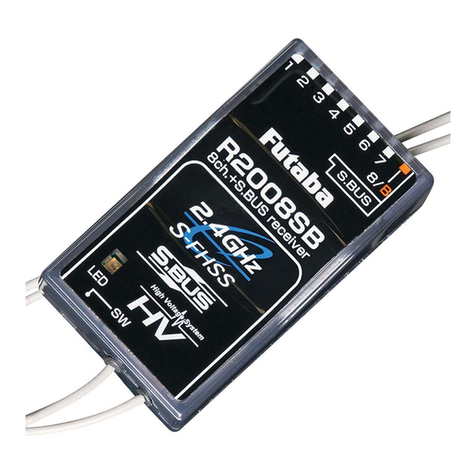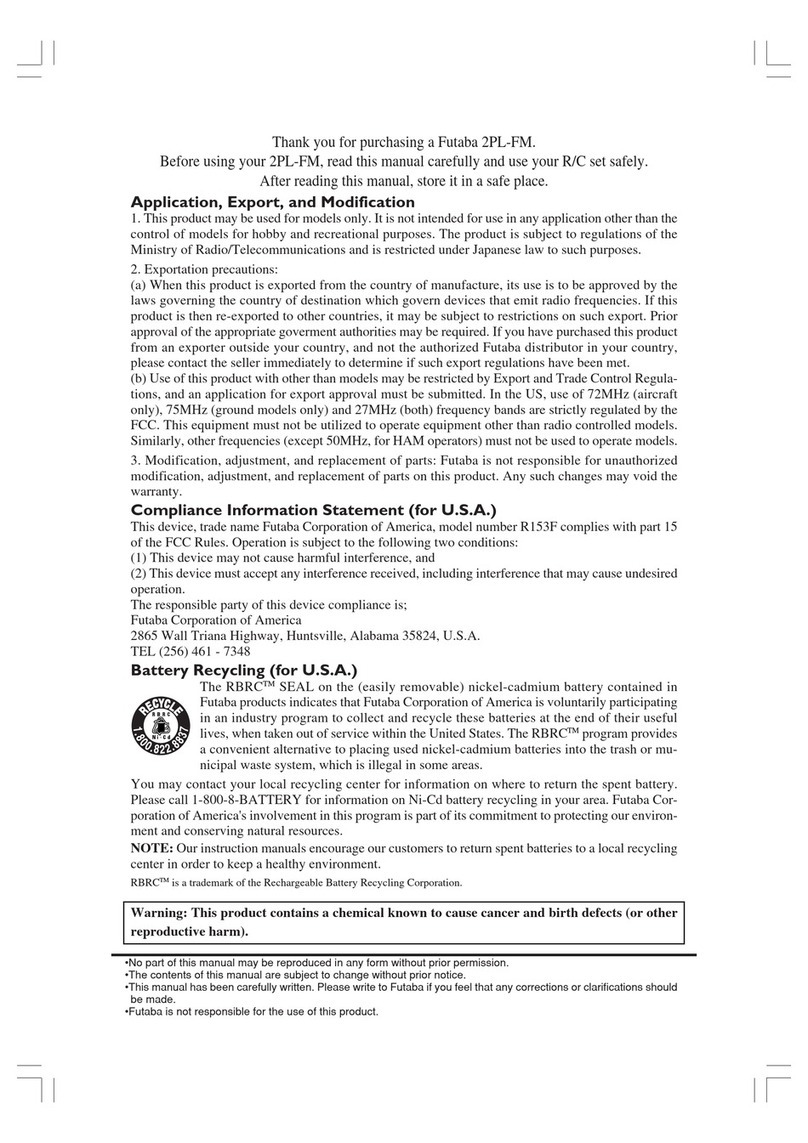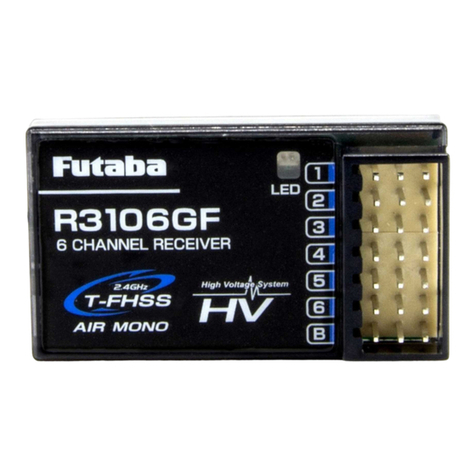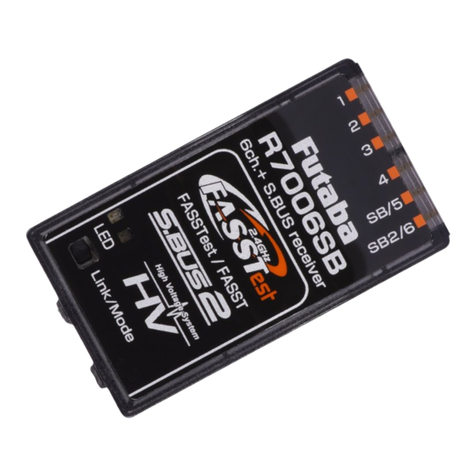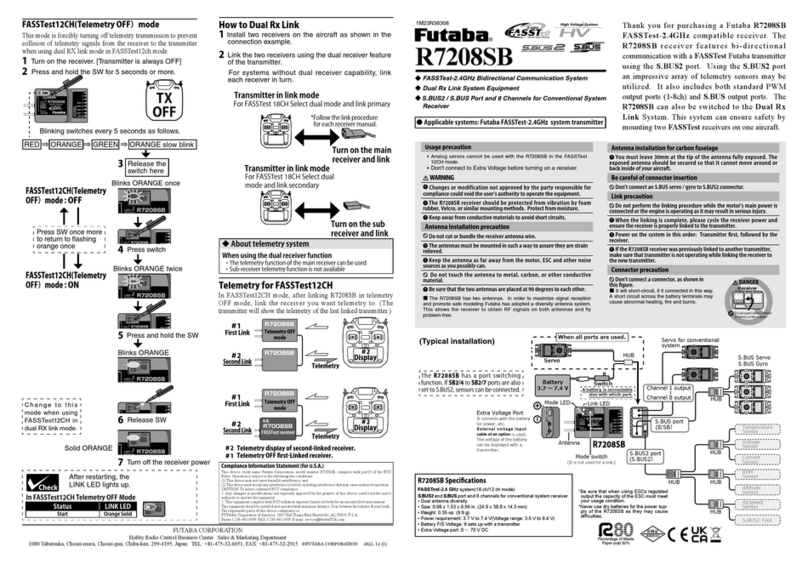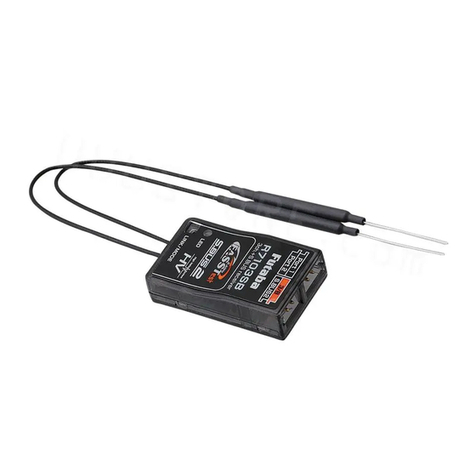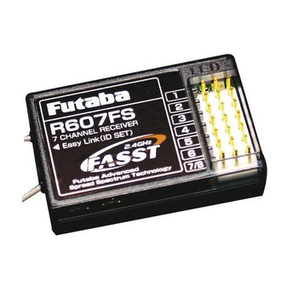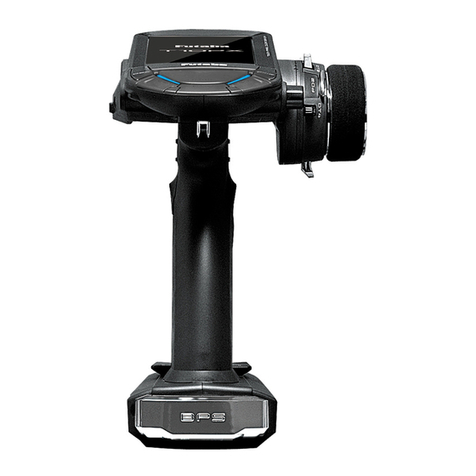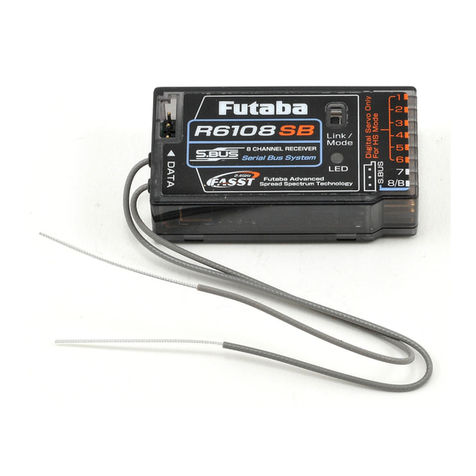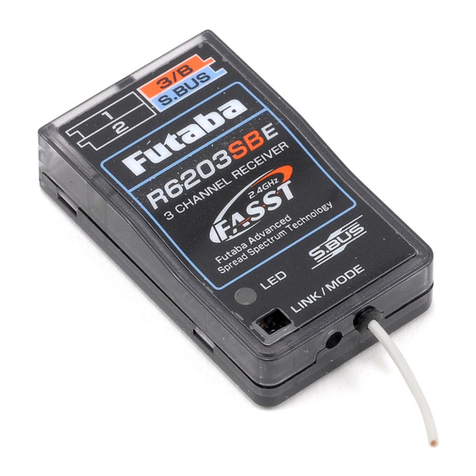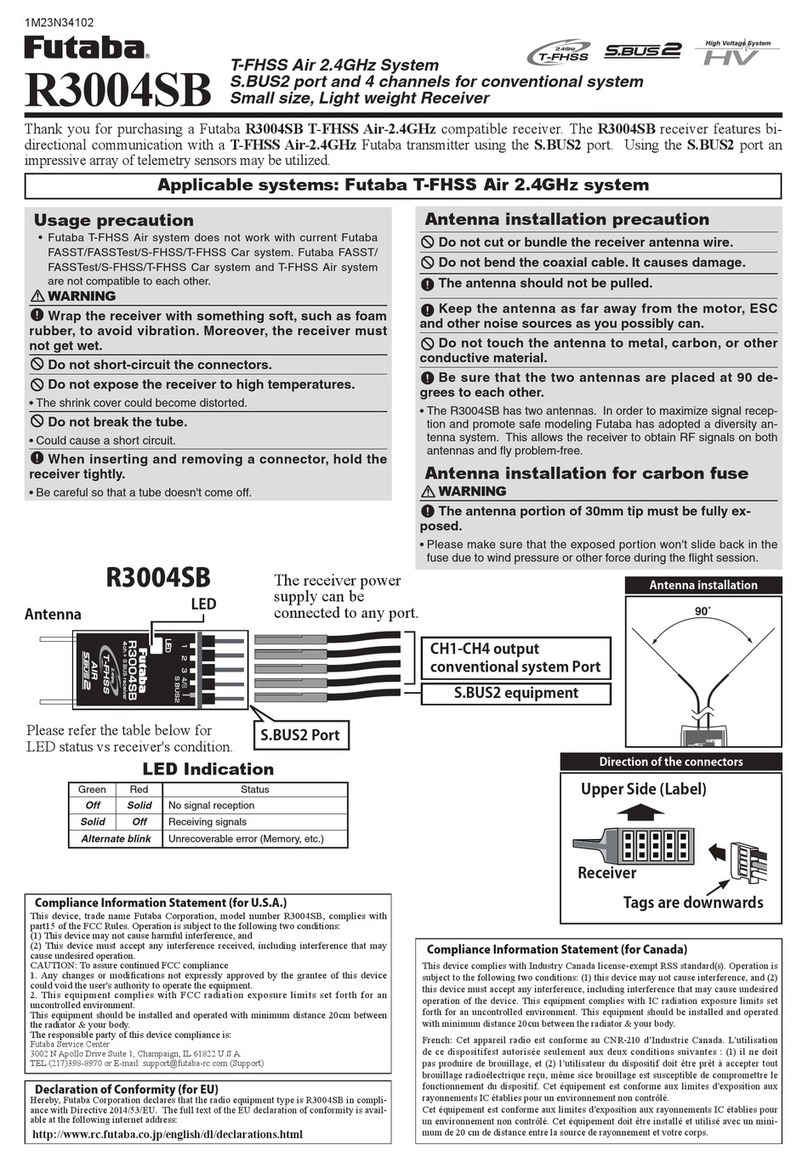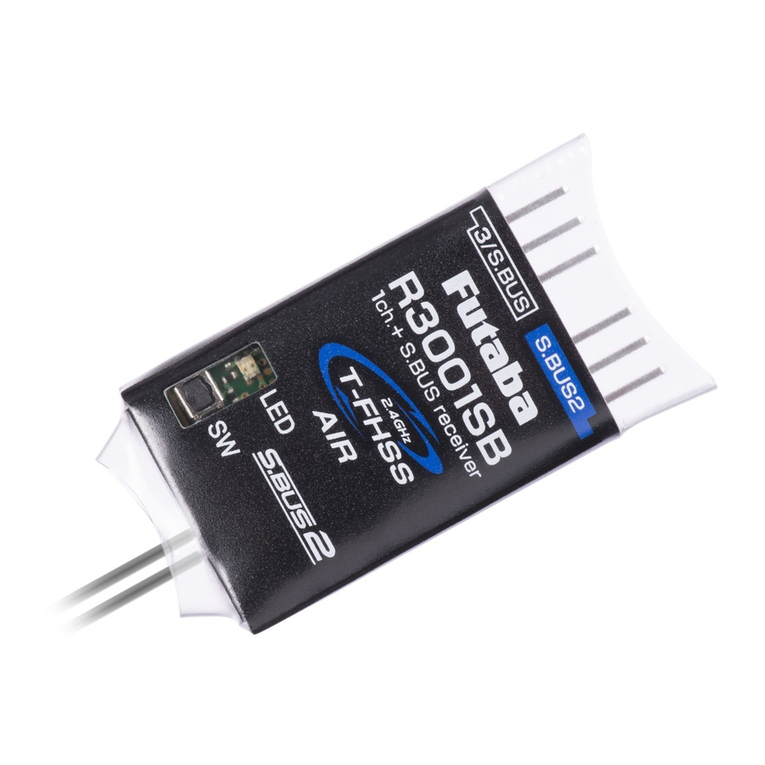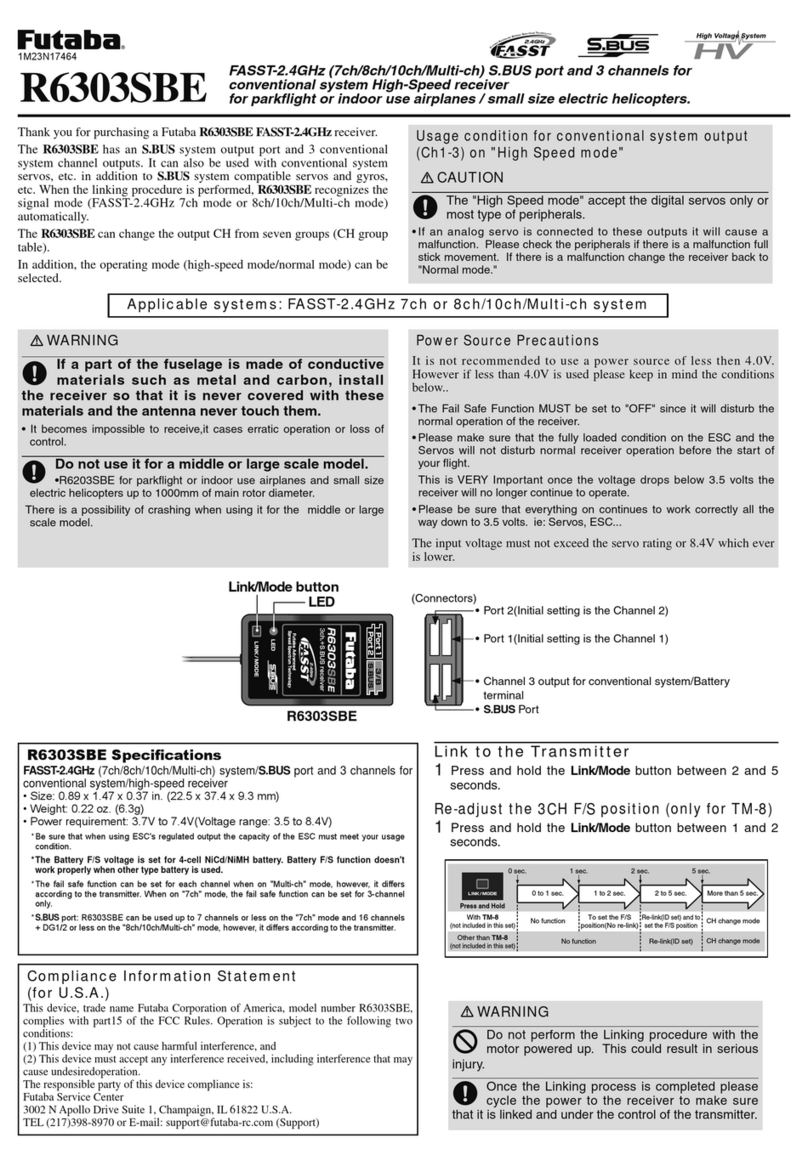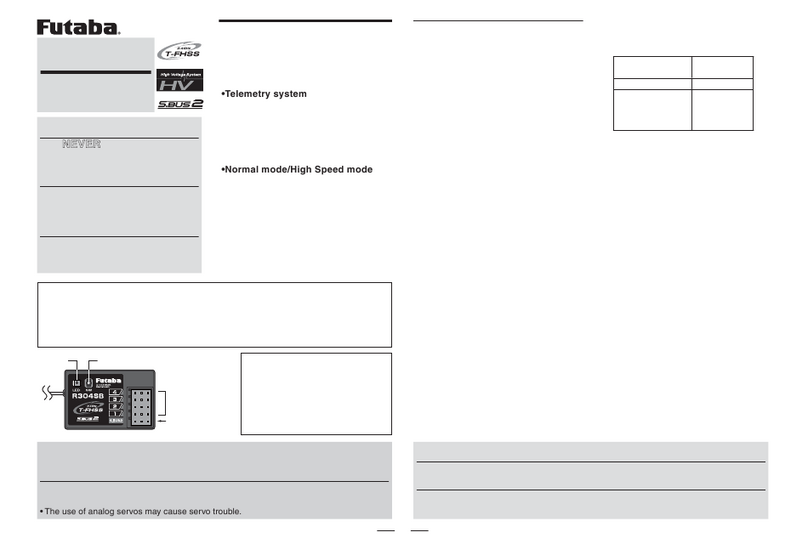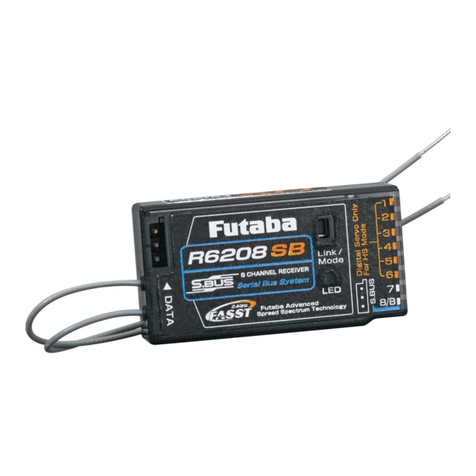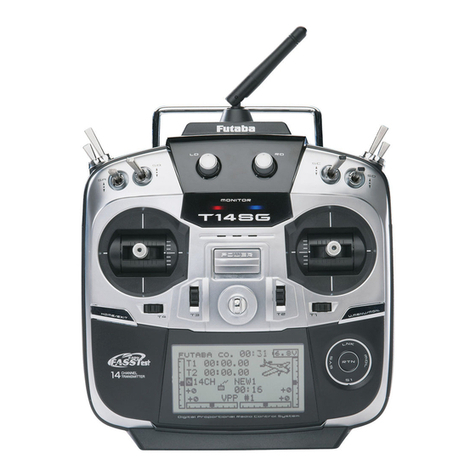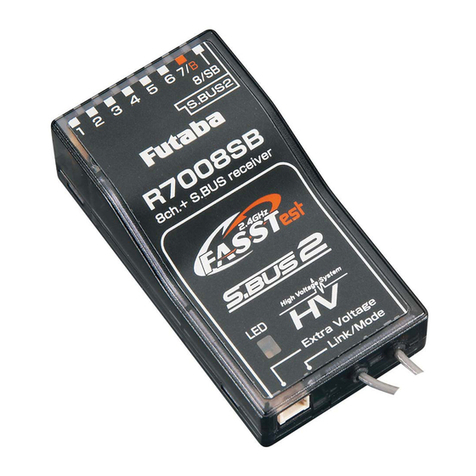Attachment of the Module
nCAUTION
jBe sure to turn off the power of the transmitter before
you install or replace the module.
1Ensure that the transmitter is set to the PPM (pulse
position modulation) mode. Please consult the
respective owner's manual for your particular transmitter
for information on how to do so.
2While it is unlikely that the existing transmitter
antenna will interfere with the radio frequency
transmission of the TM-8, we suggest removing it from
the transmitter if possible as a precaution.
3Next, with the
transmitter's power
off, remove the existing
transmitter module and
install the TM-8 module with
care so that the connector
pins of the transmitter won't
be damaged.
Antenna of TM-8
1As with all radio frequency transmissions, the
strongest area of signal transmission is from the
sides of the TM-8 transmitter module's antenna. As such,
the antenna should not be pointed directly at the model.
If your flying style creates this situation, easily move the
antenna to correct this situation.
2Please do not grasp the transmitter's antenna during
flight. Doing so may degrade the quality of the RF
transmission to the model
Easy Link
Each TM-8 transmitter module has an individually assigned
unique ID code. In order to start operation, the receiver must
be linked to the respective TM-8's ID code. Once the linking is
done, the ID code is stored in the receiver and the re-linking is
not necessary unless the receiver is to be used with a different
TM-8 module.
Additionally, it is important to note that this TM-8 and R608FS
receiver set has already been linked by the factory. Should
you wish to re-link them, or if you have purchased a separate
receiver and would like to link it to this TM-8, please adhere to
the following procedure.
nWARNING
jAfter the linking is done, please cycle receiver power
and check if the receiver to be linked is really under the
control by the transmitter to be linked.
lDo not perform the linking procedure with motor's main
wire is connected or the engine is operating as it may
result in serious injury.
1Ensure that the ch-mode select is set to the position
of the receiver's operation protocol. Please refer the
compatibility table in P4 for ch-mode select versus the
receiver to be paired.
2After the TM-8 module has been installed into the
transmitter, using the aforementioned steps, turn on
the transmitter. The green LED, located on the rear of the
TM-8 transmitter module, should begin to blink. If not,
power down the transmitter and turn it on once again.
3With the transmitter on, and the green LED blinking,
turn on the receiver.
4With the receiver on, press and hold the Easy Link
button, located on the receiver, for approximately
two seconds and release it. Then the receiver starts
linking procedure. When the linking process has been
completed, the LED on the receiver will change to a solid
green and the linking is established.
Receiver Installation
You will note that the R608FS differs in appearance from
the standard Futaba receiver. The R608FS incorporates two
separate antennas into its design which enables it to receive
the radio frequency transmission at two different locations.
Futaba's dual antenna diversity, or DAD, then seamlessly
selects the best signal reception between these antennas to
ensure that there is no loss of signal.
Antenna
*Must be kept as straight as possible.
Coaxial cable
To obtain the best results from the R608FS receiver, please
refer to the following instructions and precautions:
1Install the receiver in the aircraft using the same
methodology as you would handle a standard
receiver. That is, make sure that you wrap the receiver
in foam rubber or other such material to make it less
susceptible to vibration, etc.
2Ensure that the two receiver antennas are kept as
straight as possible. This will allow you to obtain the
maximum effective range from your model.
3If possible, please make sure that the two antennas
are placed at 90 degrees to each other. Please note:
This is not a critical figure, however, the most important
thing is to keep the antennas away from each other as
much as possible.
4If your model includes metal conductive items which
may impact the receiver's ability to clearly receive
the radio frequency signal, we suggest mounting the
receiver so that the receiver antennas exit both sides of
the model. This will allow the best radio frequency signal
condition at any flying attitude.
5Ensure that the antennas are at least 1/2" away from
any conductive materials such as metal and carbon.
Please note: this is not applicable to the coaxial portion
of the antenna. It is important, however, to not bend the
coax, or antenna in a tight radius.
6If the fuselage is made of conductive materials such
as metal and carbon, the antennas part MUST be
positioned so that they exit the fuselage. Additionally, do
not attach the antenna itself to this fuselage.
* For example, there are many types of gliders which use carbon fu-
selage. When install the receiver into such models, it is imperative
that the antenna precautions are adhered to strictly.
nWARNING
jBe very careful when handling the receiver antennas.
Repeated bending and flexing of the antennas or ex-
cessive force could weaken or compromise the internal an-
tenna connections.
jKeep the antennas away from the motor, ESC, and
other noise sources as much as possible.
Antenna Antenna
* The main purpose of the photo demonstrates how the antenna
should be placed. For actual installation the receiver must be
ZUDSSHGZLWKDVSRQJH RUSODFHGZLWK ÀRDWLQJPDWHULDOWRSURWHFW LW
from vibration.
* The receiver contains delicate electronic parts and should be pro-
tected from vibration, shock and temperature extremes.
* The receiver is not impervious to damage from moisture. If moisture
should enter the receiver, intermittent operation or failure may result.
To prevent this from occurring, we suggest wrapping the receiver in
a plastic bag or similar protective covering. This will also protect the
receiver from any fuel or exhaust residue which can work its way
into the fuselage.
Area select
The TM-8 transmitter module has been designed to function
in many countries. If you will be utilizing this module in a
country other than France, please make sure that the switch is
set to the "General" position. If, however, this module will be
utilized in France, the switch must be set to "France".
Operation of the TM-8
When the transmitter is powered up, the LEDs on the rear of
the module will begin to glow or blink accordingly. The chart
below provides you with an easy reference as to the meaning of
the LEDs.
LED indication
Green Red Status Fail safe (F/S)
Solid Solid Initializing (When Power Up) ---
Alternate blink Check RF condition nearby ---
Solid Off RF power on Off
Solid Blink RF power on (Power reduced to perform the
range check function) Off
Blink Off RF power on On
Blink Blink RF power on (Power reduced to perform the
range check function) On
F/S (Fail Safe) mode setting
The F/S is suggested for use as it offers a safety factor when
controlling your models. It is also possible to cancel the F/S
operation if you do not wish to use it.
De-activating the F/S (Failsafe)
As noted above, it is also possible to de-activate the failsafe
setting of the receiver.
Depress the F/S button on the rear of the transmitter
while turning the transmitter's power on. The LEDs
should begin to glow. Continue holding the button until
the green LED begins to glow solidly and the red LED
blinks.
Re-Arming the F/S (Failsafe)
To activate the failsafe once again, depress the F/S
button on the rear of the transmitter while turning the
transmitter's power on. The LEDs should begin to glow.
Continue holding the button until the green and Red
LED's begin blinking.
* Please note: re-arming the F/S does not alter the pre-determined
throttle servo position. To modify this setting, please follow the F/S
position setting procedure.
F/S position setting procedure
As mentioned at "Easy Link", the R608FS starts linking
process by press the Easy Link button more than two seconds.
Meanwhile, when linking is done, the R608FS stores
3ch(Throttle) position as the F/S position automatically. If you
need to change the F/S position but not need to re-link, set the
3ch(throttle) stick as desired position and press and hold the
Easy Link button just one second. By this way, the receiver
renew the F/S data for current 3ch position. Prior to doing
so, ensure that the F/S is active. If not, please follow the Re-
Arming of the F/S procedure as noted previously.
1With the transmitter's throttle stick in the desired
F/S position, and the receiver located within one
(1) meter of the transmitter, turn on the transmitter. The
green LED, located on the rear of the TM-8 transmitter
module, should begin to blink. If not, power down the
transmitter and turn it on once again.
2With the transmitter on, and the green LED blinking,
turn on the receiver. Press and hold the Easy Link
button, located on the receiver, for approximately one
second.
3
Turn off the transmitter. The throttle servo should
move to the pre-determined F/S position.
R608FS “F/S set” and “Easy-link” Operation
0 to 1 sec.1 to 2 sec.More than 2 sec.
0 sec.1 sec.2 sec.
Press and Hold time
No functionWith TM-8 To set the F/S
position(No re-link)
Re-link(ID set) and to
set the F/S position
No function
With TM-14
(not included in this set)
Re-link(ID set)
Please refer to the table below for the LED status of the
receiver's condition.
Green Red Status
Off Solid No signal reception
Solid Off Receiving signals
Blink Off Receiving signals but ID is unmatched
Alternate blink Unrecoverable failure (EEPROM, etc.)
Installing the TM-8 Module and R608FS Receiver
- 2 - - 3 -
